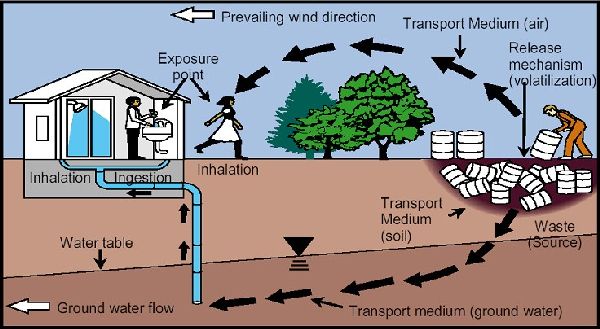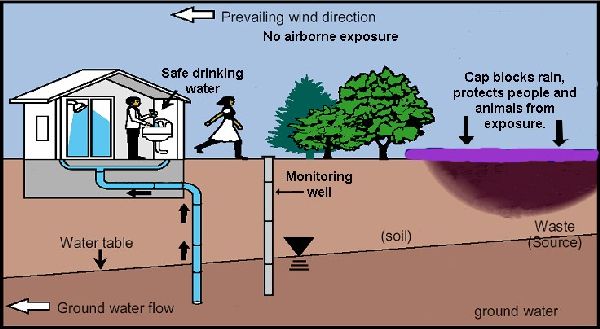Institutional Controls
An Institutional Control is defined in 18 AAC 75.990(54) as a measure taken to limit, prohibit, or protect against an activity that could (A) interfere with the integrity of contaminated site cleanup activities or improvements designed to encapsulate or control residual contamination; or (B) result in human or environmental exposure to a hazardous substance.
An IC is documentation that informs people about contamination that is present on a specific piece of property and limits activities that could result in exposure to, or the spread of, the contamination. The primary types of ICs that DEC currently uses are Environmental Covenants or Notices of Activity and Use Limitations.
What is an Environmental Covenant or Notice of Activity and Use Limitations?
When the Uniform Environmental Covenants Act (Alaska Statute (AS) 46.04.300-.390) was enacted in 2018 by the Alaska State Legislature, DEC began using Environmental Covenants as the primary institutional control type for sites with a status of “Cleanup Complete – ICs” or “Informational”. The status of “Informational” is sometimes used to distinguish those properties with Environmental Covenants or Notices of Activity and Use Limitations that are not considered source contributors (i.e., properties impacted by contamination from a contaminant source located on a separate property) . This statute includes both Environmental Covenants and Notices of Activity Use and Limitations.
An environmental covenant is a legal device that restricts activities on sites where contamination remains in place above levels that allow for unrestricted use. While the general goal of most cleanups is to return a site to a condition where it can be safely used for any purpose, this is not always technically possible or economically practicable. In these situations, a property owner may place use restrictions and institutional controls on the property to supplement cleanup measures. These restrictions are necessary to protect human health and the environment from the potential of inadvertent exposure to residual contamination while allowing for beneficial use of the property and encouraging economic development.
Why does DEC use Institutional Controls?
As a state agency with a mission to protect human health and the environment, DEC has a responsibility to all Alaskans to verify that contamination in the soil and groundwater is documented and cleaned up or effectively managed. DEC requires property owners to use ICs to minimize the potential for people to be exposed to contamination and to ensure that the remedy used to address contamination remains effective.
ICs are also used as a risk management tool to allow for the reuse and redevelopment of a property. We can manage risks at a site by applying institutional controls at sites where complete cleanup is technically or economically infeasible to inform the site's current and/or future land use. The ICs can include details and requirements specific to each site’s needs.
When are ICs used?
ICs can be applied to:
- a piece of property when contamination is first discovered,
- in the middle of a cleanup,
- when the cleanup work is completed but some contamination remains on site, and
- on properties that are not considered source contributors.
What are some examples of Institutional Control requirements?
The responsibilities and requirements for maintaining ICs are explained to property owners and documented on the DEC Contaminated Sites database where they can be publicly viewed. Depending on the site, they may also be documented in the State land records at the Alaska Department of Natural Resources (DNR) Recorder’s Office, in federal land records maintained by BLM or other agencies, on a federal, state, or municipal lands database. The 2018 Uniform Environmental Covenants Act requires environmental covenants and notices of activity and use limitations signed after that date to be recorded at the DNR Recorder’s Office; however, only a few ICs that were implemented prior to that law are recorded.
Examples of some requirements that may be included in an institutional control are:
- Restricting the use of groundwater
- Inspecting and maintaining fencing or signs to discourage people from entering an area of contamination
- Inspecting and maintaining a cap, such as asphalt, concrete, or other material, over residual contamination
- Restricting land use to commercial/industrial use only (no 24-hour occupancy)
- Restricting new construction or excavation beyond a certain depth
- Periodic review and reporting to DEC on the requirements to verify that they remain protective.
Here is an illustration showing how contamination on a residential property can lead to exposure risks for people prior to cleanup.

This property has buried drums of hazardous materials that have contaminated the groundwater and indoor and outdoor air. With no cleanup or institutional controls protecting people, they are exposed to contamination from:
- Drinking and bathing in contaminated groundwater
- Breathing contaminated air both inside and outside the home
- Direct contact with contaminated soil and dust
Here is a graphic that depicts the same piece of property after cleanup and placement of ICs.

After remediation of this property, strategic institutional control requirements are used so that people are protected from exposure. An Environmental Covenant or a Notice of Activity and Use Limitations legal document can be placed in the property records on the DNR Recorder’s Office which documents the following requirements on this property:
- A containment cap has been placed over the remaining contamination and must be inspected on a regular basis and maintained
- Excavation is prohibited without prior DEC approval
- Periodic review of the requirements will be conducted by DEC to verify that they remain protective
We regularly review and verify that the ICs remain in place, are being maintained and continue to be protective of human health and the environment.
How do I find information about properties with ICs?
The Contaminated Sites database contains information about all properties that have documented soil, surface or groundwater contamination within the state of Alaska. If a piece of property has ICs applied to it, the database site record will have the details.
The database has many different search options and filters including site name, street address, city, borough, site status, IC type, and site type. You can also search for a property using the Contaminated Sites Web Map. Once a site is selected from the database search list, the IC/Closure Details section of the property record will show whether there are ICs on the property and, if so, the details including relevant documents issued by DEC.
What if I want to buy or sell a property with ICs?
Alaska law requires that, during the sale of residential property, any known environmental hazard must be disclosed to a prospective buyer before completing the sale (Alaska Statute (AS) 34.70.010).
If cleanup has been completed and effective ICs are in place, the ICs do not typically hinder property ownership transfers since DEC has determined there is no unacceptable risks as long as the ICs are maintained. The Uniform Environmental Covenants Act requires that subsequent land owners abide by any ICs because the IC requirements enforced by an environmental covenant or a notice of activity and use limitation stay with the land, even if land ownership changes.
Because the residential property disclosure law reference above only pertains to residential properties, prospective purchasers of non-residential properties are encouraged to hire environmental professionals to perform Phase I/II Environmental Site Assessments (ESA).
Alaska Statutes and Regulations
18 Alaska Administrative Code (AAC) 75.325-390 including 18 AAC 75.375 Institutional Controls
AS 46.04.300-.390, Uniform Environmental Covenants Act
Have more questions? Visit the Contaminated Sites Program's Contact page to get in touch.
This fact sheet is one of a series of free publications prepared by DEC to help people understand contaminated site cleanup issues. The others can be found at Contaminated Sites FAQ (alaska.gov).

 Indicates an external site.
Indicates an external site.